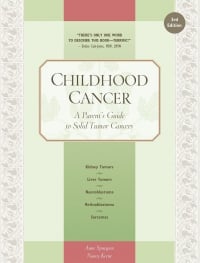Childhood Cancer
Rehabilitation needs
Rehabilitation services include physical therapy, occupational therapy, and recreational therapy. Children and teens who need rehabilitation services often start receiving them while they are in the hospital (e.g., after surgery). Then, at discharge, the oncologist will write orders for home services. Various rehabilitation services are available either privately (paid for by insurance, if covered) or through the school system.
Physical therapy
Rehab has been difficult at times. Tyler was diagnosed at age 7 with osteosarcoma and has had three leg surgeries. One to remove half of the femur with osteosarcoma, another because his bone wasn’t grafting to the donor bone, and his latest surgery was another attempt to get his bone to graft to his donor bone and fix the bowed out area of his leg. After each surgery, Tyler has had to be non-weight bearing for at least 6 months. He’s spent a tremendous amount of time in a wheelchair over the last 4 years. He has yet to be able to walk freely without assistance. Depending on his daily activities, he uses either crutches or a wheelchair. Anyone who knows the energy a young boy has, knows what a challenge this presents.
Physical therapy is a challenge. He doesn’t mind going, but to get through a session is a lot of hard work. Thankfully, he has two amazing physical therapists who work hard to make PT fun so Tyler will try his hardest to get through the session. He has PT exercises to do at home, which is a huge struggle. Being so young, it is a challenge for him to really understand that he has to put a lot of work in to regain strength in his leg. But, at the end of the day, he’s still a happy child and doesn’t let his leg disability get in the way of him enjoying life.
Physical therapy involves using exercise and motion to improve the body’s strength and movement. If an arm or leg is not moving at all, the physical therapist moves the limb through the entire range of motion to prevent the muscles from tightening during recovery. When the arm or leg begins to recover, the physical therapist devises strengthening exercises for the affected limb. Physical therapy uses equipment such as tilt tables, stationary bicycles, and treadmills. Therapy in a pool (also called aquatic therapy) is another form of physical therapy used to strengthen affected limbs.
Occupational and recreational therapy
Once Hunter was home from his operation to remove his primary tumor, he was back to himself in less than 2 weeks. However, it did take his left side many months to recover its strength. Physical therapy was provided once a week.
Occupational therapy focuses on recovering or maintaining the ability to participate in activities of daily life. For example, occupational therapists help children regain the fine motor skills needed to tie shoes, hold a pencil, eat, and dress themselves. They also evaluate the child’s need for any special equipment to maximize independence, such as an adaptive holder to help the child write with a pencil or a computer if writing by hand is not a realistic goal.
Recreational therapy also works on activities of daily living, as well as working on social and cognitive functioning, developing coping skills, and integrating children back into community settings. Examples of methods used by recreational therapists are creative arts (e.g., painting, dance, drama), sports, and leisure activities.
Accessing therapies in school
Rehabilitation helps many children make a full, or near full, recovery. These children will have the rehabilitation services slowly phased out. Other children have disabilities that require long-term rehabilitation to maximize and maintain function. Once a child re-enters the school environment, your child may be able to get rehabilitative services within the school. Schools are required to provide educationally relevant therapies (e.g., speech therapy and occupational therapy). For information about therapies provided by schools, see Chapter 22, School.
Therapeutic activities in the community
Our son had some physical therapy as soon as he could tolerate it in the hospital. He was under 3 and eligible for early intervention services (which are available to all children younger than school age who have the potential for delayed development) because of his diagnosis, so we asked for and received some physical therapy from them for a period of time after he was discharged from the hospital.
Formal rehabilitation in the outpatient or school setting is frequently enhanced by recreational activities. Community and school athletic teams are excellent therapy for children who can participate in them. The arts, such as music, painting, drama, and dance, are also very helpful.
Many communities have formal or informal therapeutic (also called adaptive) activities. Some have sports teams for children and teens with disabilities, and many communities have therapeutic riding programs for children with medical challenges.
Table of Contents
All Guides- Introduction
- 1. Diagnosis
- 2. Bone Sarcomas
- 3. Liver Cancers
- 4. Neuroblastoma
- 5. Retinoblastoma
- 6. Soft Tissue Sarcomas
- 7. Kidney Tumors
- 8. Telling Your Child and Others
- 9. Choosing a Treatment
- 10. Coping with Procedures
- 11. Forming a Partnership with the Medical Team
- 12. Hospitalization
- 13. Venous Catheters
- 14. Surgery
- 15. Chemotherapy
- 16. Common Side Effects of Treatment
- 17. Radiation Therapy
- 18. Stem Cell Transplantation
- 19. Siblings
- 20. Family and Friends
- 21. Communication and Behavior
- 22. School
- 23. Sources of Support
- 24. Nutrition
- 25. Medical and Financial Record-keeping
- 26. End of Treatment and Beyond
- 27. Recurrence
- 28. Death and Bereavement
- Appendix A. Blood Tests and What They Mean
- Appendix B. Resource Organizations
- Appendix C. Books, Websites, and Support Groups

